Hair loss can be a huge problem. And this is a problem for both men and women. Although in most cases, men are the one’s who complain from this problem. There is a solution for hair loss. And that is hair transplant.
But people generally have tons of questions when it comes to FUE hair transplant. In this article, we will answer the most frequently asked questions about FUE hair transplant.
What Is FUE Hair Transplant?
Actually, there is a misunderstand on this subject. FUE is a hair extraction technique. When combined with hair implant techniques like Sapphire, Slit and DHI, the overall process is called hair transfer. With FUE technique, hair grafts are collected from the back of the head. Also, it is possible to collect from other body parts like chest and face. After collecting these hair grafts, grafts are implanted to affected area. Number of grafts are planned before extraction and implanting procedure.
Is FUE Hair Transplant Painful?
No, it is not painful. During hair transplant, local anaesthesia is applied to both donor and recipient area. Therefore, patients do not feel anything during the surgery. There can be mild discomfort right after the surgery. But this is natural and this discomfort will pass in couple of days. Doctors prescribe pain killers to ease this process.
Is FUE Hair Transplant Permanent?
Yes, results of FUE hair transplant are permanent. So, once you have the surgery and once your grows, you will have permanent hair.
How Long Does It Take for New Hair to Grow?
After the hair transplant surgery, new transplanted hair will first fall. This is perfectly normal and natural part of recovery process. Your new hair will start to grow after six months. However, you will need 1-1.5 years for full hair growth. After completing your recovery process, your hair will look thick and the results will be permanent.
Can I Have FUE Hair Transplant?
Probably. You need to take an appointment before deciding on hair transplant. Doctor will examine you and will recommend the most suitable hair transplant option.
Does FUE Hair Transplant Have Side Effects?
No. You might feel mild pain right after the surgery. If you follow all the instructions of the doctor and medical team, you will not experience any side effects.
How Long Does It Take To Recover?
You can go back to your daily life 3 days after the surgery. Crusting will disappear over time. This time depends on characteristics of each patient. It generally takes 2 weeks.
I Am a Woman. Can I Have This Hair Transplant?
Yes you can. If you are women and experiencing hair loss, you can also have hair transplant surgery. Doctor will examine you and find the most suitable method for you.
How long does it take for the extracted hair follicles to adopt?
It may take about 10-15 days for the transplanted hair to take hold. In this process, it is necessary to be careful not to get any impact on the planting area.
Why can you not exercise after hair transplant?
It is recommended not to do sports for at least 1 month after hair transplantation. The reason for this is that the wounds in the area where the hair transplant procedure is performed have not yet fully healed. Sweating after sports can cause wounds to become infected.
Is it okay to drink juice after hair transplant?
There are drinks that you should pay attention to after hair transplantation. These; alcohol and carbonated drinks. You should avoid drinking these drinks as they will prevent the hair from clinging or prolong the process. Of course, you can drink fruit juices that you prepare at home.
How do hair grafts get extracted?
Hair grafts are taken from the upper part of the nape area behind the two ears with the help of a micromotor. This method is called FUE. The micro motor ensures that the hair comes out together with the root.
How long should I sleep on my back after hair transplant?
After hair transplantation, your way of lying down may change. This will usually be on the back. This process varies from one week to 10 days, depending on the person.
Does rain affect hair transplant results?
Raindrops coming to your newly planted hair will not harm your hair. Just make sure that the raindrops are not falling hard and fast. If you are not in a hurry, it will be more beneficial for you to wait for the rain to stop. You may damage the grafts because I will protect them from the rain.
What food can you not eat after hair transplant?
After hair transplantation, you should pay attention to eating healthy meals. In particular, we recommend that you stay away from excessively oily meals. The healthy food you eat ensures that the blood in your body circulates more easily. This ensures that your hair is well nourished.
How do I maximize the survival rate of implanted hair?
The adhesion of 80% of the transplanted hair indicates that the procedure is successful. The higher we keep this rate, the higher our success rate will be. What you need to do for this is to follow the advice given to you by the doctor.
Is it okay to scratch my hair after hair transplant?
It is normal for your head to be itchy after hair transplantation. Of course, you cannot touch the planted area. If your planting area is very itchy, you can wash your head with cold water.
How does a hair transplant work?
A hair transplant involves removing hair follicles from one part of the scalp (the donor area) and transplanting them to a bald or thinning area (the recipient area). This is usually done using one of two methods: Follicular Unit Transplantation (FUT) or Follicular Unit Extraction (FUE).
Is a hair transplant permanent?
Hair transplants are generally considered permanent, as the transplanted hair is not susceptible to the same factors that cause hair loss, such as genetics and aging. However, it is possible for some of the transplanted hair to fall out in the weeks following the procedure, and it may take several months for the full results to be visible.
What is the success rate of hair transplants?
The success rate of hair transplants varies depending on a number of factors, including the patient's age, the extent of hair loss, and the type of hair transplant procedure used. In general, hair transplants are considered to be highly successful, with a success rate of 95% or higher.
Are there any risks or side effects associated with hair transplants?
As with any surgical procedure, there are some risks and potential side effects associated with hair transplants. These can include bleeding, infection, and scarring. In rare cases, patients may experience allergic reactions to the anaesthetic used during the procedure.
How much does a hair transplant cost?
The cost of a hair transplant can vary widely depending on the extent of the procedure and the location of the clinic. In general, hair transplants can cost anywhere from a few thousand dollars to over $10,000. It is important to research different clinics and compare prices before making a decision.
Who is a good candidate for a hair transplant?
Good candidates for a hair transplant are typically in good overall health and have realistic expectations about the procedure. They should also have sufficient hair in the donor area, as this is where the hair follicles will be taken from.
How long does a hair transplant take?
The length of a hair transplant procedure can vary depending on the extent of the transplant and the method used. FUT procedures tend to take longer than FUE procedures. In general, a hair transplant can take anywhere from a few hours to an entire day to complete.
Is a hair transplant painful?
Most patients report that a hair transplant is not particularly painful, as local anaesthetic is used to numb the scalp during the procedure. Some patients may experience discomfort or a feeling of pressure during the procedure, but this is generally minimal.
How long does it take to recover from a hair transplant?
Recovery from a hair transplant generally takes a few days to a week. During this time, the scalp may be sore and tender, and patients may need to take pain medication and avoid physical activity. Most patients are able to return to work and other normal activities within a few days of the procedure.
Can hair transplants be combined with other hair loss treatments?
Hair transplants can be combined with other hair loss treatments, such as medications like finasteride and minoxidil, to achieve the best possible results. It is important to discuss all treatment options with a hair loss specialist to determine the best approach for your specific needs.
Can hair transplants be used to treat all types of hair loss?
Hair transplants can be effective for treating certain types of hair loss, including male and female pattern baldness, thinning hair, and scarring alopecia. However, they may not be suitable for all types of hair loss, such as hair loss due to hormonal imbalances or medical conditions. It is important to consult with a hair loss specialist to determine if a hair transplant is an appropriate treatment option for you.
Can a hair transplant be performed on anyone?
Hair transplants can be performed on most people, as long as they are in good overall health and have sufficient hair in the donor area. However, some individuals, such as those with certain medical conditions or those who are pregnant or breastfeeding, may not be suitable candidates for a hair transplant.
Can a hair transplant be performed more than once?
In some cases, a hair transplant may need to be performed more than once to achieve the desired results. This can depend on the extent of the hair loss, the method used for the transplant, and the individual's hair growth cycle. It is important to discuss your goals and expectations with a hair loss specialist to determine if multiple hair transplants are necessary.
Can a hair transplant be performed on any part of the body?
Hair transplants are typically performed on the scalp, as this is where the majority of hair loss occurs. However, they can also be used to restore eyebrows, eyelashes, and facial hair.
How long do the results of a hair transplant last?
The results of a hair transplant are generally long-lasting, with many patients experiencing permanent hair growth. However, it is important to note that the transplanted hair is still subject to the normal hair growth cycle, so some shedding may occur. Proper hair care, including using gentle shampoos and avoiding tight hairstyles, can help to ensure the best possible results.





